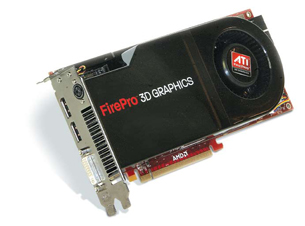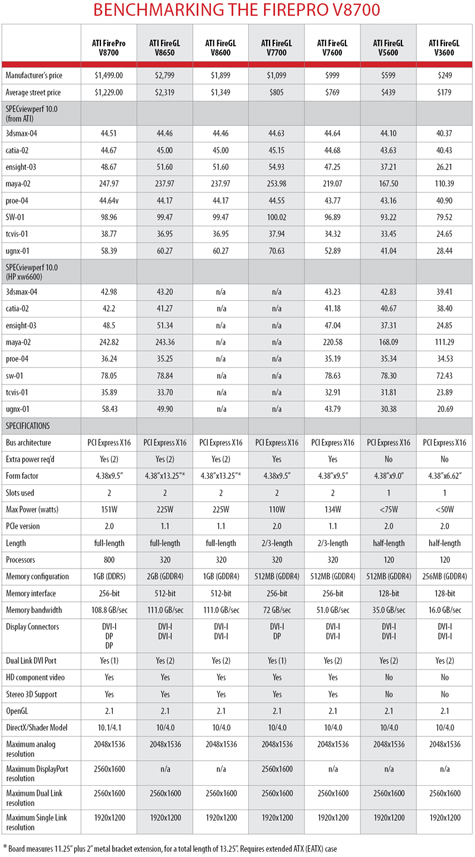Latest News
December 4, 2001
By David Cohn
 The new ATI FirePro V8700 from AMD is smaller and less expensive than its predecessor and yet delivers equal or better performance. Image courtesy David Cohn |
Last spring, with the announcement of the ATI FireGL V7700 graphics accelerator, AMD (Sunnyvale, CA) became the first company to introduce a 3D workstation-class graphics card with DisplayPort support. That card turned out to be the last in the company’s FireGL V-series. During the summer of 2008, AMD unveiled a new product line, the ATI FirePro. Like its predecessor, this new series of 3D workstation graphics cards combine a new ATI OpenGL optimized driver with the company’s ATI FireGL graphics technology to deliver a new level of graphics performance.
AMD recently sent us its new top-of-the-line FirePro, the V8700. Billed as an ultra high-end graphics accelerator, it comes with 1GB of GDDR5 frame buffer memory and AMD’s latest generation GPU with an astounding 800 unified shader units, or Stream processing units as the company calls them. According to AMD, the ATI FirePro V8700 provides a 40 percent performance gain for memory-intensive applications compared to the previous ATI FireGL products.
The new ATI FirePro V8700, which plugs into a PCI Express X16 graphics slot, is smaller than the FireGL V8600, measuring 4.38 in. x 9.5 in. And at 151 watts, it consumes considerably less power. But like its predecessor, it still requires two auxiliary connections to the system power supply. A large cooling fan and plastic cowl protrude more than an inch from the board, making it impossible to make use of the adjacent expansion slot.
Like the ATI FireGL V7700, the new FirePro V8700 departs from the past, providing just a single dual-link DVI-I connector. But it includes two of the new DisplayPort (DP) connectors. There’s also a stereo sync output.
The new DP standard was introduced by VESA (the Video Electronics Standards Association) in 2006 as a replacement for both DVI and analog VGA. The USB-sized DP connector secures without thumbscrews, making it well suited for mobile and handheld devices. While not compatible with HDMI or DVI, it does support pass-through of those signals, and AMD makes it easy to support legacy devices by including three adapters: a DP to single-link DVI-I connector, a DVI-I to VGA adapter, and a DVI-I to component video adapter.
 Benchmark results for the FirePro V8700 as well as the previous generation FireGL V-series boards we tested last year. |
The ATI FirePro V8700 board’s 30-bit display pipeline (10-bit per RGB component) produces more than one billion colors. The board supports one or two analog displays at resolutions up to 2048 x 1536 at 85Hz and digital displays at resolutions up to 1920 x 1200 for single link, 2560 x 1600 for dual link at 60Hz refresh, or as high as 3840 x 2400 at 24/41Hz refresh rate. When driving two monitors, users can configure display resolution, refresh rate, and resolution independently for each display.
Like the previous generation ATI FireGL boards, the ATI FirePro V8700 features AMD’s AutoDetect, which optimizes the graphics driver based on the user’s specific software application even while running multiple programs simultaneously. The board also supports High Dynamic Range (HDR) rendering with up to 16-bit per RGB color component for a wider spectrum of color, thereby creating natural lighting and shading effects.
The ATI FirePro V8700 has a 256-bit memory interface, half that of the FireGL V8600, but increases the memory bandwidth slightly to 108.8GBps. The new board is also PCIe 2.0 compatible (the FireGL V8600 only supported PCIe 1.1). The FirePro V8700 supports OpenGL 2.1 as well as DirectX 10.1 and Shader Model 4.1, enabling hardware acceleration of most professional 3D graphics software.
Our Benchmarks and Theirs
AMD has performed its own benchmark tests, which are published on the company’s website. To see the power of the new graphics accelerator for ourselves, we ran our own benchmarks.
We installed the AMD ATI FirePro V8700 in the same HP xw6600 workstation we used in our wrapup of last year’s ATI graphics boards (see DE September 2008) so all of our results are directly comparable. We’ve also tested all of the most recent NVIDIA graphics accelerators in this same system, which is equipped with a pair of 3.0GHz Quad-Core Xeon E5450 processors. This system is a very close match to the computer AMD used to produce its own results.
Our SPEC Viewperf numbers confirm those from AMD, showing that the FirePro V8700 performed equal to, or slightly faster than, the FireGL V8600 and V8650, while costing significantly less than its predecessor.
 The ATI FirePro V8700 provides only one DVI-I port and a stereo 3D port, but offers two of the new DisplayPort connectors. Photo by David Cohn |
Like other workstation-class graphics accelerators from AMD, the new ATI FirePro V8700 is fully certified with most CAD and DCC applications and uses AMD’s unified Catalyst display driver. Drivers are available for Windows Vista and Windows XP (both 32- and 64-bit) as well as Linux 32 and 64.
AMD backs this and its other ATI FirePro boards with a three-year limited product repair/replacement warranty and provides toll-free phone and e-mail access to its dedicated workstation technical support team.
A board like the ATI FirePro V8700 is likely overkill for midrange CAD users. But for those who demand the utmost in performance, this board delivers significant speed at an affordable price. The manufacturer’s suggested retail price is $1,499 but the AMD ATI FirePro V8700 is readily available through most retailers at an average street price of just $1,229. At that price, it’s hard to pass up this level of performance.
More Info
AMD
Sunnyvale, CA
Requirements: PCI Express-based workstation with available x16 lane graphics slot; 450-watt power supply or greater (assumes fully loaded system); two 2x3 power connectors; Microsoft Windows Vista (64-bit or 32-bit), Microsoft Windows XP (64-bit or 32-bit), or Linux (64-bit or 32-bit).
Contributing Editor David Cohn is a computer consultant and technical writer based in Bellingham, WA, and has been benchmarking PCs since 1984. He’s the former editor-in-chief of Engineering Automation Report and CADCAMNet, and the author of more than a dozen books. Please send comments about this article to [email protected]. You can also contact David at [email protected].
Subscribe to our FREE magazine, FREE email newsletters or both!
Latest News
About the Author
David Cohn is a consultant and technical writer based in Bellingham, WA, and has been benchmarking PCs since 1984. He is a Contributing Editor to Digital Engineering, the former senior content manager at 4D Technologies, and the author of more than a dozen books. Email at [email protected] or visit his website at www.dscohn.com.
Follow DE





